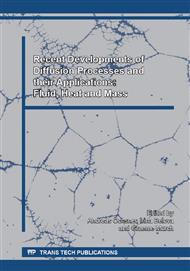p.27
p.35
p.44
p.61
p.71
p.80
p.92
p.104
p.112
The Interpretation of Marker Experiment Conducted during Formation of Higher Oxide on the Surface of Lower Oxide
Abstract:
The marker method in studying the formation mechanism and defect structure of higher oxide during oxidation of lower oxide has been discussed. The approach to this problem needs specific treatment, both in experimental procedure and in the interpretation of results. It has been shown that the correct results of marker experiments in the case of highly defected substrates can be obtained, if these substrates before the marker deposition process are submitted to homogenization under highest oxidant activity, at which they remain stable at a given temperature. In addition, the nonstoichiometry must be considered in formulating appropriate chemical reactions, being the basis for foreseeing the location of markers in the interior of reaction product. The other very important problem consists in the possibility of the formation of reaction product not only on the surface of oxidized substrate but also inside of this substrate. In such a situation, the formulation of final conclusions concerning the crystalline lattice disorder from marker position should be combined with considerations of chemical reactions and transport processes occurring in a given substrate.
Info:
Periodical:
Pages:
71-79
Citation:
Online since:
June 2015
Authors:
Price:
Сopyright:
© 2015 Trans Tech Publications Ltd. All Rights Reserved
Share:
Citation:


